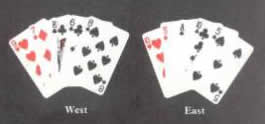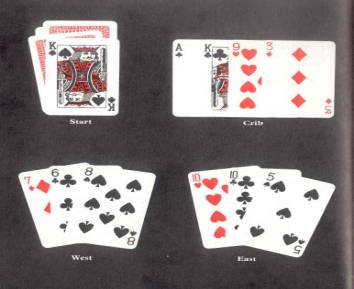This ends the play, and the players, beginning with the non-dealer, count their scores by combining their own cards with the start. The dealer then exposes the crib (it is his exclusive property) and any values that he finds in it (making full use of the start) he pegs to his score sheet. Should either player hold the Jack of the same suit as the start he pegs one (One for his Nob).
If a player holds in his hand three cards all of the same suit he pegs three for a flush, and four if the start is of the same suit. In the crib, however, nothing is scores for a flush unless, with the start, it is a flush of five; if it is the dealer pegs five.

Two other features of the scoring call for special mention. First, player must count his hand aloud, and if he overlooks any score, either in play or otherwise, his opponent may call ‘Muggins’, point out the omission, and peg the score for himself.
Secondly, if a player reaches the game hole before his opponent has gone halfway round the board a lurch is scored, that is to say the winner scores two games instead of only one. Points are scored during the play by a player adding the value of the card played by the opponent to a card played from his own hand.
Thus if a 10 or court card is led, and a player plays a 5, he scores 15 and pegs two holes (fifteen–two as it is called for short). If a 6 is led, and he plays another 6, he scores for a pair and pegs two. Again, a 4 is led, he plays a 6, and the opponent plays a 5: he pegs three for a sequence and two for 15. And so on.
The general principles may be illustrated in an elementary deal. East is the dealer.
West holds a sequence of four. As a result the ♣ K will go to the crib, and for his other card he must choose between the ♣ 6 and the ♥ 9.
There is not much in it, but as the ♣ is of the same suit as the King, there is a slight advantage in discarding the ♥ 9, because the ♣ 6 (along with the king) might help to give East a poker flush in his crib.
East has an easy choice of discards. Indeed, it is obvious that he will discard the ♣ A and ♦ 3.
West cuts the cards, and East turns up the ♠ K. the position is now as in the illustration below:

West leads the ♦ 7 and says ‘Seven’. It is his best lead because if East plays an 8 and pegs two for 15, West can play the ♣ 6 and peg three for sequence. He will not, of course, play the ♠ 8, because if East holds another 8 he will play it and not only peg for a pair-royal but for 31 as well.
In the event, East cannot play an 8 and score for 15. His best play, therefore, is the ♣ 10, announcing ‘Seven-teen’. This makes it impossible for a 15 to be scored against him.
West has no better play than the ♠ 8, announcing ‘Twenty-five’ , because the closer the total to 31 the better the chance that East will be unable to play.
East plays the ♠ 5, announcing ‘Thirty’. West says ‘Go’ and as East has not got an Ace he pegs one for Last. The hands are now counted.
West is not helped by the start. All he can score is two for 15 and three for sequence. This with his Three for Last (as non-dealer) gives him eight.
East pegs six for 15 (two 10s and the ♠ K in the start, each combined with the ♠ 5) and two for the pair of 10s. in the crib he finds an Ace, a King, a 9 and a 3. With the start this gives him two for the pair of Kings. He therefore pegs 10 holes, making 11 in all as he has already pegged One for Last.
